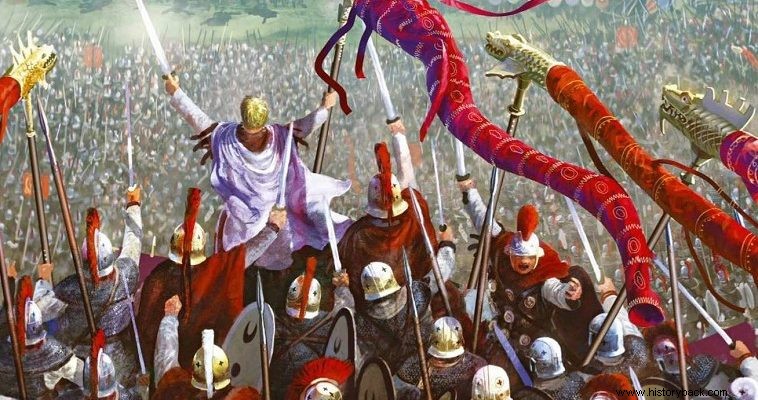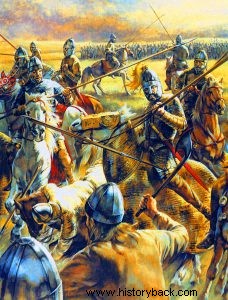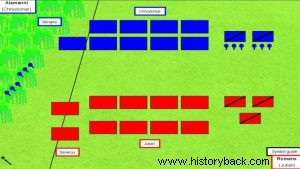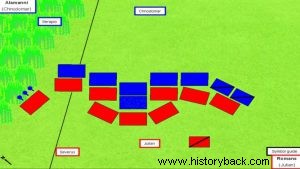
In 355 AD the situation in the western part of the Roman Empire was just not good. The Germans (Alemanni and Franks), had breached the border of the Rhine and invaded as far as Gaul. The emperor Constantius then ordered his cousin – one of the few relatives he had left alive – Julian, the later emperor whom the Church labeled a "transgressor" or "apostate", to restore the situation.
However, Constantius gave Julian only 360 horsemen. After a series of maneuvers, in the summer of 357 AD. Julian moved against the Alamanni and their Burgundian allies. The main source for the battle is the contemporary of the events – probably Greek – historian Ammianus Marcellinus. According to Ammianus, Julian reached the area of Oberhausbergen, about 3 km SW of Strasbourg, after a six-hour march and decided to rest his men first. But the latter refused and asked him to lead them immediately into battle.
Opposing forces and arrangement
At the same time the ruler of the Alamanni Cnodomar saw the small Roman army and moved almost three times his forces against it. Julian ordered all his cavalry to his right – about 3,000 men in two lines. In the center he ordered 4,000 heavy infantry, supported on either side by lighter divisions. In the second line, approximately 1,000 archers were deployed with the task of supporting the first line units with overhead shots.
Finally, on his left, in front of which there was a dense forest, he ordered about 2,000 infantry under general Severus. He himself with 200 elite horsemen of their guard lined up in the center of the line, having as a reserve also about 3,000 infantry.
Against him the Alamanni hid about 2,000 of their light infantry in the forest, against the Roman left, while the bulk of their infantry marched against the centre, against the Roman infantry in dense masses. The approximately 4,000 Alamanni cavalry charged against the Roman cavalry supported by light infantry. The German cavalry lined up in dense formation to withstand the onslaught of Julian's approximately 1,000 barricaded horsemen.
Epic battle
When the two armies were ready the Alamanni and their Burgundian allies demanded that their leader should take the lead of the infantry and lead them into battle. Cnodomar did so but in doing so he was reduced from being a general to a mere warrior among thousands of others, losing all control of his army.
The battle began with Julian unleashing his "Sagittarius" (horse archers) against the enemy cavalry in order to cause casualties and confusion. Then the Roman heavy cavalry attacked. But the German light infantry supporting the cavalry proved to be a decisive factor. The German foot soldiers fought extremely skillfully, beating the Roman horses.
The unbelievable happened. The Roman shutters fled and they almost broke the line of the friendly infantry as well, which was avoided thanks to the intervention of Julian. According to the historian Zosimos, a unit of barricades whose men refused to return to the field, Julian ordered them to wear women's clothing.
The rest of the Roman cavalry covered the flank of the friendly infantry and immobilized the German cavalry. However, Julian's main advantage from which he expected victory had been neutralized. Emboldened by this the Germans rushed against the Roman infantry with wild shouts and clamours. The Roman infantry formed a wall of shields and by launching a shower of missiles - riptaria (small missiles something between a small javelin and a large arrow, with a counterweight, launched by the men by hand), javelins and arrows caused great losses to their opponents. strong>
Seeing this elite German warriors formed a wedge and attacked again. In this way they succeeded in causing a breach in the Roman infantry line. Everything indicated that soon Julian's small army would be annihilated. Although it was cut in two, the Roman faction endured even if they were separated. At the same time Severus, suspecting a trap, did not move into the forest. But the Germans, losing their patience and seeing their center defeated, rushed against the men of Severus disorderly only to be defeated. Meanwhile, Julian moved his reserve in order to close the gap in the center.
The Germans made the mistake of going too far by attacking the second Roman line without having neutralized the first. Thus receiving blows from three directions, those Germans who penetrated were mercilessly slaughtered. But the force of Severus now entered the battle in the center, now without an opponent, he was able to attack the Germans on their right flank. The breach in the center had been closed and all the Roman infantry now charged against the disorganized enemy. Soon they found themselves 3/4 surrounded and receiving overwhelming blows they fled pursued by the light divisions and cavalry of the Romans...
Carnage ensued as the Germans were trapped before their enemies and the Rhine. Thousands were slaughtered, still more surrendered and many drowned trying to swim in the great river. Ammianus reports that 6,000 Germans were killed, 8,000 captured, including their leader, and 2,000 drowned. The Romans had only 243 dead.

The defeat of the Roman barriers.

Battle of Strasbourg. The original arrangement of opponents.

The German attack, the breach and restoration of the Roman line.
